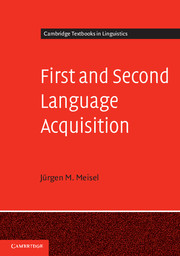Crossref Citations
This Book has been
cited by the following publications. This list is generated based on data provided by Crossref.
Sharwood Smith, Michael
and
Truscott, John
1920.
The Multilingual Mind.
MEISEL, JÜRGEN M.
2011.
Parametric variation in acquisition and diachronic change: A response to the commentaries.
Bilingualism: Language and Cognition,
Vol. 14,
Issue. 2,
p.
165.
Meisel, Jürgen M.
Elsig, Martin
and
Bonnesen, Matthias
2011.
Delayed grammatical acquisition in first language development.
Linguistic Approaches to Bilingualism,
Vol. 1,
Issue. 4,
p.
347.
Carroll, Susanne E.
2012.
The Encyclopedia of Applied Linguistics.
KUPISCH, TANJA
2012.
Specific and generic subjects in the Italian of German–Italian simultaneous bilinguals and L2 learners.
Bilingualism: Language and Cognition,
Vol. 15,
Issue. 4,
p.
736.
Meisel, Jürgen M.
2013.
Remarks on the acquisition of Basque–Spanish bilingualism.
International Journal of Bilingualism,
Vol. 17,
Issue. 3,
p.
392.
Cromdal, Jakob
2013.
Bilingual and second language interactions: Views from Scandinavia.
International Journal of Bilingualism,
Vol. 17,
Issue. 2,
p.
121.
Granena, Gisela
and
Long, Michael H
2013.
Age of onset, length of residence, language aptitude, and ultimate L2 attainment in three linguistic domains.
Second Language Research,
Vol. 29,
Issue. 3,
p.
311.
Slabakova, Roumyana
2013.
Adult second language acquisition.
Linguistic Approaches to Bilingualism,
Vol. 3,
Issue. 1,
p.
48.
Ezeizabarrena, Maria-José
2013.
Overt subjects in early Basque and other null subject languages.
International Journal of Bilingualism,
Vol. 17,
Issue. 3,
p.
309.
Pérez‐Leroux, Ana Teresa
and
Thomas, Danielle
2013.
The Handbook of Spanish Second Language Acquisition.
p.
423.
Pérez-Leroux, Ana T
2014.
Commentary to ‘Multiple Grammars and second language representation’, by Luiz Amaral and Tom Roeper.
Second Language Research,
Vol. 30,
Issue. 1,
p.
59.
Meisel, Jürgen M.
2014.
On timing in monolingual and bilingual acquisition.
Linguistic Approaches to Bilingualism,
Vol. 4,
Issue. 3,
p.
357.
KUPISCH, TANJA
LEIN, TATJANA
BARTON, DAGMAR
SCHRÖDER, DAWN JUDITH
STANGEN, ILSE
and
STOEHR, ANTJE
2014.
Acquisition outcomes across domains in adult simultaneous bilinguals with French as weaker and stronger language.
Journal of French Language Studies,
Vol. 24,
Issue. 3,
p.
347.
Snape, Neal
Matthews, John
Hirakawa, Makiko
Hirakawa, Yahiro
and
Hosoi, Hironobu
2014.
Aspect in L2 English.
EUROSLA Yearbook,
Vol. 14,
Issue. ,
p.
79.
Ortega, Lourdes
2014.
Interlanguage.
Vol. 39,
Issue. ,
p.
173.
Rankin, Tom
2014.
Word order and case in the comprehension of L2 German by L1 English speakers.
EUROSLA Yearbook,
Vol. 14,
Issue. ,
p.
201.
Stein, Achim
2014.
Einführung in die französische Sprachwissenschaft.
p.
209.
Long, Drew
and
Rothman, Jason
2014.
Some caveats to the role of input in the timing of child bilingualism.
Linguistic Approaches to Bilingualism,
Vol. 4,
Issue. 3,
p.
351.
Gómez Soler, Inmaculada
2014.
Beyond interfaces.
Linguistic Approaches to Bilingualism,
Vol. 4,
Issue. 4,
p.
494.



